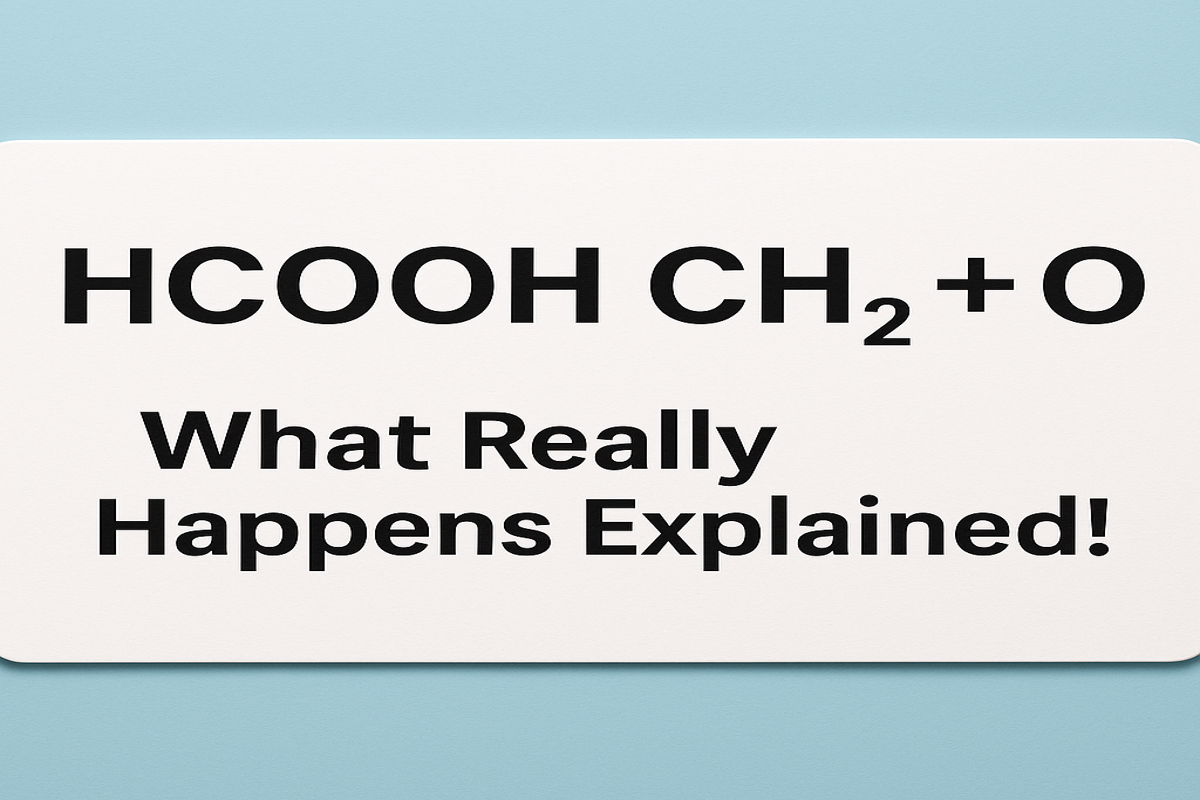
Understanding the HCOOH CH₂ + H₂O reaction made simple and clear.
Introduction
A Simple Look at HCOOH, CH₂, and H₂O
Chemistry can be one of those subjects that seem to have too many letters and numbers. But don’t worry! But, we’re kicking off these basics with something rather simple but oh-so crucial: the reaction between HCOOH, CH₂, and H₂O, three unassuming combinations of letters that each play big roles in chemical reactions. You’re in the right place if you’ve ever wondered what happens when they converge.
Why This Reaction Matters More Than You Think
It’s not just scientists who have something to learn about this reaction. It crops up naturally in industries, even in what we use as consumers. And as you finish this guide, you’ll see why these small molecules impact the world around us momentously. So, let us begin by making chemistry less of a mystery and more of a story!
Understanding the Players
What Is HCOOH?
The chemical formula for formic acid is HCOOH. This is a humble organic acid found in ant venom (yes, it’s more complicated than it sounds!). Formic acid is colorless, possesses a pungent smell, and is very reactive. It is common in manufacturing leather, on farms , and in laboratories.
A Quick Dive Into CH₂
CH₂ may seem small, but it packs a big punch. It is shorthand for methylene, a key building block of many organic molecules. It is frequently used as a building block, enabling chains and larger structures to form in organic chemistry. Imagine it as a Lego brick in this universe of molecules!
The Role of Water (H₂O) in Reactions
Good old H₂O, better known as water, is the consummate team player in chemistry. It doesn’t just sit there passively — it makes molecules meet, react, and change. Depending on the scenario, water may serve as a solvent, reagent, or catalyst. Here, the reaction is active, and water participates in it.
Setting the Stage: How the Reaction Starts
Conditions Needed for the Reaction
To get HCOOH, CH₂, and H₂O to react effectively, you’ve got to have the right conditions. As a rule, temperature, pressure, and, occasionally, the nature of a catalyst affect the rate and yield of the reaction. And with the wrong arrangement, molecules could sit there and sulk.
What Makes These Molecules React?
Molecules are reacting because they’re searching for stability. Electrons rearrange to form lower energy bonds, making the system more stable. In the case of HCOOH, CH₂, and H₂O, some attractions and repulsions between their atoms lead them to stick together freshly.
Breaking Down the Reaction Step-by-Step
First Contact: HCOOH Meets CH₂
When HCOOH meets CH₂, a new act is set. As an acid, HCOOH will give up a proton (H⁺). CH₂ is ready for interaction — it has double bonds or active sites. Together, they create an intermediate form that’s begging only for water now.
How Water (H₂O) Steps In and Changes the Game
Enter H₂O! Water enters to help control the reaction, either donating necessary protons or accepting by-products. Water can create hydrogen bonds, enabling the process to occur more smoothly and reducing the energy required to rearrange the molecules.
The Bonds That Break and the Bonds That Form
In other words, bonds break, atoms move, and new bonds form. In the process, the formic acid may lose hydrogen, CH₂ may form a new bond, and water may bind temporarily or permanently. The specific products can be more complicated, depending on the conditions. Still, you can generally think of something new and relatively stable forming:cdeclared_argument_type = void. You can also use it on free function pointers to remove the function argument.
The Science Behind the Scenes
Electron Movement and Energy Shifts
When molecules react, it’s electrons all the way down. They go from high-energy, unstable states to low-energy, stable ones. This electron dance influences how fast and complete the reaction is. Formic acid loses some electron density , and CH₂ becomes stabilized by new bonds.
Stability Factors and Molecular Behavior
Happy molecules are stable molecules. The system usually ends up in a lower energy state after the reaction. That’s why chemical reactions like this occur spontaneously — everything in the universe has a soft spot for a little more stability.
Real-World Applications
Where You See This Reaction in Everyday Life
Amazingly, it has real-world effects when you react this way! Some uses for formic acid reactions include preserving animal feed, rubber production, and certain cleaning products. Whenever you use a cleaner that smells sharp or is preserving something naturally, thank the reactions like HCOOH + CH₂ + H₂O.
Industrial and Research Uses You Didn’t Know About
Industries employ reactions with formic acid for dyeing textiles, tanning leather, and making artificial flavors. Formic acid, in research, is a model molecule for understanding what organic acids do, for insights into energy conversion, and to learn how molecules change and interact.
Common Misunderstandings Explained
HCOOH vs. Formaldehyde Confusion
Some individuals mistakenly equate formic acid (HCOOH) to formaldehyde (HCHO). Even though they sound alike, there is a big difference between them! Formaldehyde is a deadly gas used for preservation, as formic acid is a liquid organic acid. Never forget to double-check those chemical formulas!
The Myth of “Instant Reaction”
Some believe that simply stirring chemicals will create an instantaneous, explosive reaction. That is not true here! Temperature, concentration, catalysts — all determine the reaction’s speed and the product’s. With the wrong setup, you will see a very sluggish or no reaction at all.
Can You Speed It Up?
Yes! If you manipulate the heat or introduce a catalyst, the reaction can occur more quickly. Scientists frequently play with reaction conditions in search of the right “sweet spot” where everything goes smoothly and efficiently.
Fun Chemistry Facts Related to HCOOH and H₂O
Formic Acid in Nature
Formic acid isn’t just for the laboratory. Ants and bees and even some plants make it naturally! It’s how they defend themselves by stinging predators. Nature was the first chemist, eons before humans figured out how to make color.
Water: The Ultimate Reaction Partner
And without water, many reactions we take for granted wouldn’t happen. Water stabilizes ions and ferries protons around, and it can even help become part of the final product. Elsewhere, it’s as if the stage manager is assuring the show goes on backstage.
Troubleshooting the Reaction
What Happens If Conditions Aren’t Right?
The temperature could be too low, or perhaps the molecules aren’t pure enough, and that reaction might go nowhere. You might get no visible change or some undesired side products. Chemistry is always carefully controlling your environment!
How to Identify Mistakes and Fix Them
Common problems are that there isn’t enough formic acid, too much water changes the reaction, or impurities are causing side reactions. Testing and changing settings a bit at a time is how you cure any chemistry issue.
Future Possibilities
New Studies on Organic Reactions with H₂O
Scientists are always searching for ways that water can drive reactions forward. Future work could reveal even cleaner, faster, more efficient ways to use water in reactions with organic acids such as HCOOH.
The Role of AI in Predicting Chemical Behavior
The long and the short: Believe it or not, AI is being used to help chemists predict how reactions such as HCOOH + CH₂ + H₂O will behave! AI models simulate millions of possible responses and identify the best routes without the need to conduct millions of experiments in a lab.
Final Thoughts
Why Knowing These Basics Matters
Learning simple reactions is a good basis for learning significant, complex chemistry. Understanding how HCOOH, CH₂, and H₂O interact can explain many industrial, natural, and biological processes.
The Beauty of Simple Chemical Reactions
Occasionally, the most straightforward responses make for the most interesting stories. Molecules shimmy, electrons shuffle, and new creations take their form — all imperceptible to the naked eye but so central to life as we understand it. Magic is transformation; chemistry is magic at its very core.
FAQs
What does HCOOH stand for?
HCOOH is the formula of formic acid, a simple, naturally occurring organic acid.
How does CH₂ react with HCOOH and H₂O?
CH₂ functions as a reactive site where HCOOH attaches, and water helps to stabilize the reaction.
Why is water (H₂O) necessary in this reaction?
Water is not simply a bystander — it assists in transferring protons and ensures a smooth reaction.
Can this reaction happen without water?
It can get going but won’t be as fast and efficient as otherwise.
Where do we see reactions like this in real life?
They are found in agriculture, textiles, and nature — even in ant venom and other natural preservatives!





